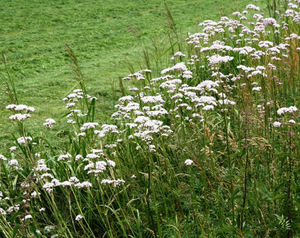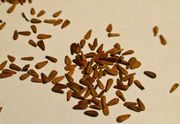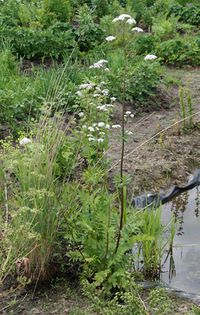Valerian
| Valerian | |
|---|---|

| |
| Wild valerian growing at the edge of my garden | |
| Scientific classification | |
| Kingdom: | Plantae |
| Order: | Dipsacales |
| Family: | Valerianaceae |
| Genus: | Valeriana |
| Species: | V. officinalis |
| Binomial name | |
| Valeriana officinalis | |
- By John Eagles
Valerian is a hardy perennial that is native to Europe and parts of Asia and has been introduced into North America. In the sixteenth century flower extracts were used as a perfume. Valerian has been used as a medicinal herb since ancient times, and often as a remedy for insomnia.
Medical uses
Valerian has been used as a mild sedative and pain reliever and for migraine treatment. The main constituent of valerian is a yellowish-brownish-green oil that is present in the dried root. Plants growing on a dry, stony soil contain more of this ingredient than plants on moist and fertile soils. The volatile oils have a somewhat earthly scent. Valerian tea should not be prepared with boiling water as this may evaporate the oils.
Valerian is used for insomnia and as a sedative for nervous tension and stress, as a muscle relaxant, and also for intestinal cramps. The Wikipedia article gives elaborate information about studies that have been conducted about the effects of valerian.[1]
One study found that valerian has a balancing effect: sedates the nervous person and stimulates the fatigued one.
Typical doses of the crude herb vary from 2-10 grams per day. Valerian root is nontoxic but may cause side effects such as lightheadedness and disorientation when taken in excessive doses. Personally i take valerian only in very small doses as even the smallest amount makes my head feel dizzy (JE). In rare cases valerian may cause allergic reactions such as skin rash or difficulty breathing. Some precaution is advised for the use by pregnant women.
Gallery
See also
References
External links
- Dietary supplement fact sheet for valerian Office of Dietary Supplements
- Growing valerian
- Valerian Wikipedia
Comments
: You need to be logged into your Facebook account to post comments






